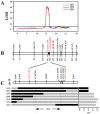Fine Mapping and Candidate Gene Prediction of Tuber Shape Controlling Ro Locus Based on Integrating Genetic and Transcriptomic Analyses in Potato
- PMID: 35163389
- PMCID: PMC8836246
- DOI: 10.3390/ijms23031470
Fine Mapping and Candidate Gene Prediction of Tuber Shape Controlling Ro Locus Based on Integrating Genetic and Transcriptomic Analyses in Potato
Abstract
Tuber shape is one of the most important quality traits in potato appearance. Since poor or irregular shape results in higher costs for processing and influences the consumers' willingness to purchase, breeding for shape uniformity and shallow eye depth is highly important. Previous studies showed that the major round tuber shape controlling locus, the Ro locus, is located on chromosome 10. However, fine mapping and cloning of tuber shape genes have not been reported. In this study, the analyses of tissue sectioning and transcriptome sequencing showed that the developmental differences between round and elongated tuber shapes begin as early as the hook stage of the stolon. To fine map tuber shape genes, a high-density genetic linkage map of the Ro region on chromosome 10 based on a diploid segregating population was constructed. The total length of the genetic linkage map was 25.8 cM and the average marker interval was 1.98 cM. Combined with phenotypic data collected from 2014 to 2017, one major quantitative trait locus (QTL) for tuber shape was identified, which explained 61.7-72.9% of the tuber shape variation. Through the results of genotyping and phenotypic investigation of recombinant individuals, Ro was fine mapped in a 193.43 kb interval, which contained 18 genes. Five candidate genes were preliminarily predicted based on tissue sections and transcriptome sequencing. This study provides an important basis for cloning Ro gene(s).
Keywords: QTL; Solanum tuberosum L.; candidate gene prediction; tuber shape.
Conflict of interest statement
The authors declare no conflict of interest.
Figures






Similar articles
-
Tuber shape and eye depth variation in a diploid family of Andean potatoes.BMC Genet. 2015 May 30;16:57. doi: 10.1186/s12863-015-0213-0. BMC Genet. 2015. PMID: 26024857 Free PMC article.
-
Linkage analysis and QTL mapping in a tetraploid russet mapping population of potato.BMC Genet. 2018 Sep 21;19(1):87. doi: 10.1186/s12863-018-0672-1. BMC Genet. 2018. PMID: 30241465 Free PMC article.
-
Inheritance and genetic mapping of tuber eye depth in cultivated diploid potatoes.Theor Appl Genet. 2005 Apr;110(6):1068-73. doi: 10.1007/s00122-005-1927-6. Epub 2005 Feb 18. Theor Appl Genet. 2005. PMID: 15719211
-
Molecular signals that govern tuber development in potato.Int J Dev Biol. 2020;64(1-2-3):133-140. doi: 10.1387/ijdb.190132ab. Int J Dev Biol. 2020. PMID: 32659001 Review.
-
Auxin: An emerging regulator of tuber and storage root development.Plant Sci. 2021 May;306:110854. doi: 10.1016/j.plantsci.2021.110854. Epub 2021 Feb 18. Plant Sci. 2021. PMID: 33775360 Review.
Cited by
-
Integration of multi-omics technologies for crop improvement: Status and prospects.Front Bioinform. 2022 Oct 19;2:1027457. doi: 10.3389/fbinf.2022.1027457. eCollection 2022. Front Bioinform. 2022. PMID: 36438626 Free PMC article.
-
QTL analysis of tuber shape in a diploid potato population.Front Plant Sci. 2022 Nov 10;13:1046287. doi: 10.3389/fpls.2022.1046287. eCollection 2022. Front Plant Sci. 2022. PMID: 36438140 Free PMC article.
-
Insights into the genetic determination of tuber shape and eye depth in potato natural population based on autotetraploid potato genome.Front Plant Sci. 2023 Mar 28;14:1080666. doi: 10.3389/fpls.2023.1080666. eCollection 2023. Front Plant Sci. 2023. PMID: 37056497 Free PMC article.
-
Fine Mapping and Candidate Genes Analysis for Regulatory Gene of Anthocyanin Synthesis in the Corolla, Shedding Light on Wild Potato Evolution.Int J Mol Sci. 2025 Feb 25;26(5):1966. doi: 10.3390/ijms26051966. Int J Mol Sci. 2025. PMID: 40076591 Free PMC article.
-
The effect of marker types and density on genomic prediction and GWAS of key performance traits in tetraploid potato.Front Plant Sci. 2024 Mar 8;15:1340189. doi: 10.3389/fpls.2024.1340189. eCollection 2024. Front Plant Sci. 2024. PMID: 38525152 Free PMC article.
References
-
- Hirsch C.N., Hirsch C.D., Felcher K., Coombs J., Zarka D., Deynze A.V., Jong W.D., Veilleux R.E., Jansky S., Bethke P. Retrospective View of North American Potato (Solanum tuberosum L.) Breeding in the 20th and 21st Centuries. G3 Genes Genomes Genet. 2013;3:1003–1013. doi: 10.1534/g3.113.005595. - DOI - PMC - PubMed
-
- Si Y., Sankaran S., Knowles N.R., Pavek M.J. Potato Tuber Length-Width Ratio Assessment Using Image Analysis. Am. J. Potato Res. 2016;94:88–93. doi: 10.1007/s12230-016-9545-1. - DOI
-
- Jong H.D., Burns V.J. Inheritance of tuber shape in cultivated diploid potatoes. Am. Potato J. 1993;70:267–284. doi: 10.1007/BF02849314. - DOI
MeSH terms
Grants and funding
LinkOut - more resources
Full Text Sources
Research Materials

